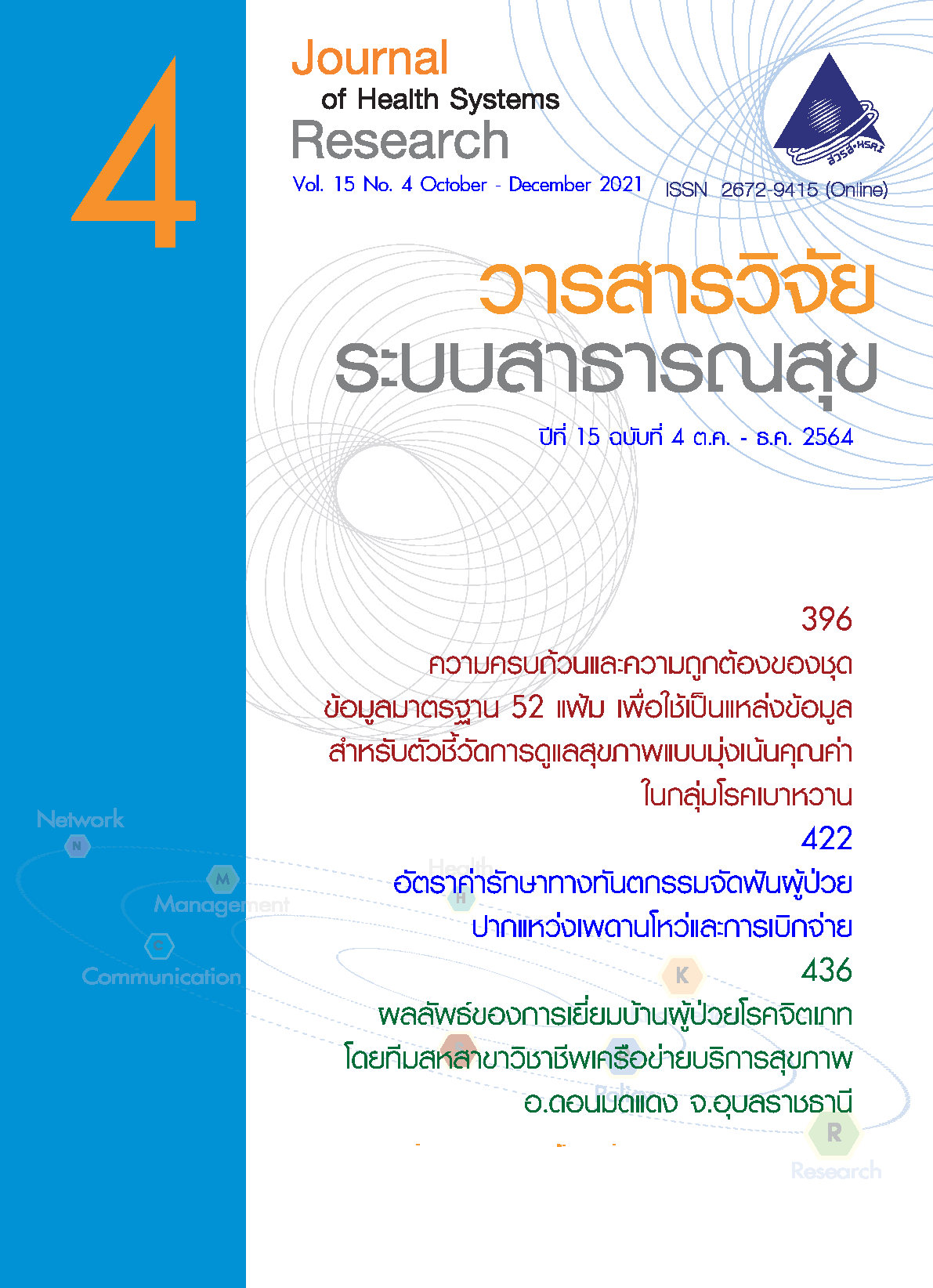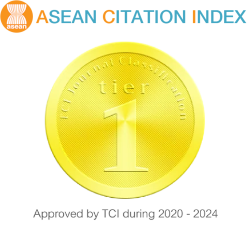Asbestos-Related Disease Cases in Thailand: Starting from Health Data Center
Abstract
Six types of asbestos can be classified into 2 groups: amphiboles and serpentines. Amphibole asbestos which has straight, needle-like fiber includes actinolite, tremolite, anthophyllite, crocidolite, and amosite. Serpentine asbestos which has long, curly fiber includes chrysotile. Nowadays, only chrysotile is used for commercial and industrial purposes. It is used in roofing, thermal and electrical insulation, cement pipe and sheets, flooring, gaskets, friction materials (brakes, clutches), coating and compounds, plastics, textiles, paper, mastics, thread, fiber jointing, and millboard. All kinds of asbestos are human carcinogens.(1) Asbestos causes asbestos-related diseases (ARDs): asbestosis, pleural plaque, and cancers such as mesothelioma, lung cancer, ovarian cancer, and laryngeal cancer.
Estimation of mesothelioma patients based on asbestos usage in Thailand (2.5 kg/year/capita in the year 2002); there will be 1,103 mesothelioma patients per year.(2) However, only a small number of mesothelioma and other ARDS patients were reported in Thailand.(3,4) Survey for real cases of mesothelioma and other ARDS is needed to convince non-scientific community that ARDs are real and must be reduced.(5) Asbestos usage in Thailand in the year 2020 was 0.5 kg/year/capita.(6)
Health Data Center (HDC) of Thailand’s Ministry of Public Health is a national database for reporting diseases from all hospitals under Ministry of Public Health. HDC has started since 2014 but data have been reported full function since 2015. There are 3 types of ARDs reported to HDC: mesothelioma (ICD-10TM CODE C45.0-C45.9), asbestosis (ICD-10TM CODE J61), and pleural plaque (ICD-10TM CODE J92.0). These data have not been verified.(7)
Data reported to Health Data Center (HDC) during January 1, 2015 and December 31, 2016 were searched for asbestos-related diseases. There were 3 types of asbestos-related diseases reported to HDC; mesothelioma ((ICD-10TM CODE C45.0-45.9), asbestosis (ICD-10TM CODE J61), and pleural plaque (ICD-10TM CODE J92.0). Then, occupational health nurses in general hospitals screened the report cases to exclude cases reported by mistakes such as wrong coding. Finally, a team of occupational physicians verified the screened cases by reviewing medical chart of each patient.
Occupational and environmental histories were obtained, by occupational physicians or nurses of that hospital, from patients or relatives of asbestosrelated patients.
There were 243 mesotheliomas and 142 asbestosis and pleural plaque cases reported to HDC during January 1, 2015 and December 31, 2016. After occupational health nurses screened, there were 262 cases of wrong coding (68% of total cases reported). The remaining 123 cases included 83 mesothelioma cases, 30 asbestosis cases, and 10 pleural plaque cases. Occupational physicians finally verified these 123 cases as mentioned in methods and found that there were 26 true mesothelioma cases which were 21 cases of mesothelioma of pleura, 3 cases of mesothelioma of peritoneum, 1 case of mesothelioma of pericardium, and 1 case of mesothelioma of testis. There were 1 true case of asbestosis and pleural plaque each.
For occupational and environmental history of asbestos exposure, there were 5 out of 26 mesothelioma cases that had occupational exposure to asbestos (19.2% of mesothelioma cases). Among 5 cases that had occupational exposure history to asbestos, 1 case worked in roof tile factory and 4 cases worked as construction workers previously. There were 1 (3.8%) out of 26 mesothelioma cases that had environmental exposure to asbestos by staying at his home in construction site. For asbestosis and pleural plaque cases, each of them had occupational history of asbestos exposure.
In 2015-2016, 26 mesothelioma cases, 1 asbestosis case and 1 pleural plaque case in Thailand were verified. Among 26 mesothelioma cases, there were 21 cases of mesothelioma of pleura, 3 cases of mesothelioma of peritoneum, 1 case of mesothelioma of pericardium, and 1 case of mesothelioma of testis. Verified ARDs cases were very low compared to estimation from other studies. From global burden of diseases compare (GBD compare) data, mesothelioma deaths in Thailand in 2015 was estimated to be 315 deaths from occupational exposure and 149 deaths from environmental exposure and 11 asbestosis deaths.(8) From GBD compare, mesothelioma deaths in Thailand in 2016 was estimated to be 222 deaths from occupational exposure and 34 deaths from environmental exposure and 4 asbestosis deaths.(8) For recent data, the GBD compare estimated mesothelioma deaths to be 164.42 deaths and asbestosis deaths to be 1.22 deaths in Thailand in 2019.(9) From global burden of diseases mesothelioma study, 539 mesothelioma deaths per year in Thailand were estimated.(10) Of course, this underreport resulted from the fact that we could not find ARDs among those diagnosed as non-ARDs to find false negative case. World Health Organization stated that “recognizing that the most efficient way to eliminate asbestos-related diseases is to stop the use of all types of asbestos.”(11)
References
International Agency for Research on Cancer. IARC monographs on the evaluation of carcinogenic risks to human volume 100c: a review of human carcinogens: arsenic, metals, fibres, and dusts. Geneva: International Agency for Research on Cancer; 2012.
Tossavainen A. Global use of asbestos and the incidence of mesothelioma. Int J Occup Environ Health 2004;10: 22–5.
Wongvitvichot S, Jiamjarasrangsi W, Sriuranpong V. Occupational Malignant Mesothelioma in Thailand. J Health Science 2009;18:155-62. (in Thai)
Subhannachart P, Dumavibhat N, Siriruttanapruk S. Asbestos-related diseases in Thailand and review literature. J Med Assoc Thai 2012;95 (Suppl 8):S71-6.
Sithisarankul P. Proceedings of the Conference on the Medical Status of ASEAN Countries. Bangkok: Bangkok Medical Publisher; 2016.
Thai Customs [homepage on the internet]. Statistics report on import and export. Available from: http://www.customs.go.th/statistic_report.php?lang=en&ini_content=statistics_report&&left_menu=nmenu_esevice_007. [accessed on 2021 Dec 13].
Information and Communication Technology Center, Ministry of Public Health, Thailand [homepage on the internet]. Health Data Center (HDC) 2016. Available form: https://hdcservice.moph.go.th/hdc/reports/page.php?-cat_id=f16421e617aed29602f9f09d951cce68. [accessed on 2016 Nov 10].
The Institute for Health Metrics and Evaluation [homepage on the internet]. GBD compare 2018. Available from: https://vizhub.healthdata.org/gbd-compare/. [accessed on 2018 Mar 28].
The Institute for Health Metrics and Evaluation [homepage on the internet]. GBD compare 2018. Available from: https://vizhub.healthdata.org/gbd-compare/. [accessed on 2021 Dec 13].
Odgerel CO, Takahashi K, Sorahan T, Driscoll T, Fitzmaurice C, Yoko-O M, et al. Estimation of the global burden of mesothelioma deaths from incomplete national mortality data. Occup Environ Med 2017;74:851-8.
World Health Organization [homepage on the internet]. Asbestos: elimination of asbestos-related diseases. Available from: https://www.who.int/news-room/fact-sheets/detail/asbestos-elimination-of-asbestos-related-diseases. [accessed on 2021 Dec 13].
Downloads
Published
How to Cite
Issue
Section
License
Copyright (c) 2025 Journal of Health Systems Research

This work is licensed under a Creative Commons Attribution-NonCommercial-NoDerivatives 4.0 International License.
Journal of Health Systems Research is licensed under a Creative Commons Attribution-NonCommercial-NoDerivatives 4.0 International (CC BY-NC-ND 4.0) license, unless otherwise stated.




